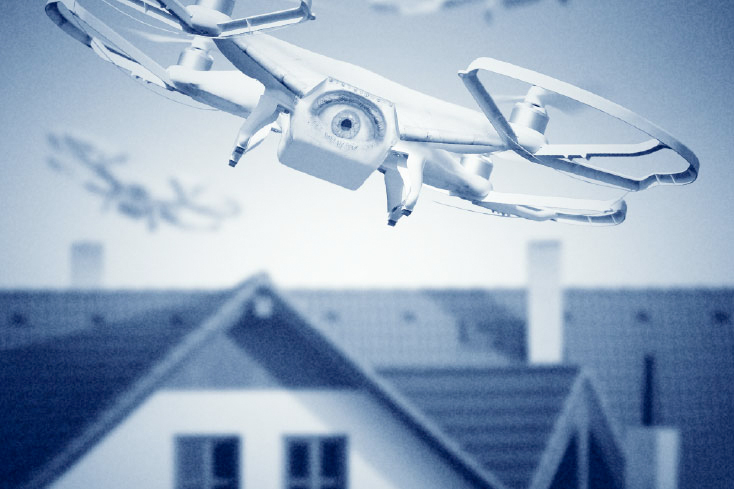By Andre A. Janiszewski
In the United States, the Federal Aviation Administration (“FAA”) estimates that, by 2020, there will be seven million drones in the skies. That is more than triple the current number of drones. Their prevalence quickly grabbed the FAA’s attention. In October 2017, they found that drone related incidents, such as flying improperly or flying too close to other aircraft average about 250 per month. That number is fifty percent more than the number of reported occurrences last year. And, the damage that a drone can cause is not insignificant. A recent study found that a four-pound drone could penetrate an airliner’s fuselage – a significantly larger threat than what a bird could manage. In the U.K., for example, pilots reported only six drone incidents in 2014, but as of October 2017, there had been 81. The pervasive use and general inexperience of those piloting drones have led lawmakers to develop new laws to regulate the popular technology.
To help solve these problems, the United States, as well as other countries around the world, have introduced prophylactic drone laws. For example, the FAA requires a person to obtain a drone license prior to operation. In addition, all drones must be registered and cannot be flown out of eyesight. Drones cannot be operated at more than 400 feet and more than 100 miles per hour. Finally, if one intends to fly a drone within five miles of an airport, they must give air traffic control advanced notice. Some states have taken the initiative to regulate drones as well.
A new bill has been introduced by the United Kingdom in order to regulate drones. The regulations are vast, and differ from those in the United States in various respects. There are provisions which are very similar to those in America. There will be a cap on drones flying above 400 feet, and a mandatory registry for drones weighing over 55-pounds. The bill will force prospective drone users to sit for a test to determine if they are safe enough to fly. It is currently unclear how in-depth or extensive the testing will be, but users will no longer be able to legally purchase and use drones without taking some sort of course. This is a massive change from current U.K. practices, which have virtually no regulation at all.
One of the more legally interesting aspects of the bill is that it will give the police the authority to seize drones that they suspect were involved with criminal activity. Earlier this year, a video emerged of a drone attempting to deliver drugs and mobile phones into a London prison. Vigilance of officers prevented the drop-off, but the incident raised significant criminal concerns. In the United States, there was a similar incident in September 2017. A drone carrying marijuana and cell phones crashed into a prison yard in Arizona. Investigators have been so far unable to determine where the drone originated. Similar incidents have been reported in California, Ohio, and Michigan, all to the frustration of law enforcement officers in these states. They are worried about people smuggling weapons, including firearms, into prisons. Drone technology has made their use simpler and cheaper, and these worries do not go unheard.
News reports have indicated that Ohio has been one of the first states to consider investing in a “drone defender” program. This technology will allow prisons to bring small drones down, to avoid these kinds of issues. Experts predict that this technology will extend to outdoor theaters and stadiums as well. The technology sets up a sort of “geo-perimeter” which, if a drone enters, sets off a signal that a breach has occurred. Massachusetts has implemented a similar version of this technology at the Boston Marathon.
The U.K.’s law which stops a drone’s use in criminal activities is already been implemented by some U.S. states. For example, Florida proscribes the use of a drone in violating a person’s reasonable expectation of privacy. This standard is nebulous. The Supreme Court is currently dealing with a case about a reasonable expectation of privacy in cell-site location information. It is relevant here because new technology poses difficult questions. As drones become more and more ubiquitous, courts will have to decide legal questions of users’ rights to drones. It seems clear that there are minimal constitutional implications in using a drone. While flying a drone around your property is protected, using it in criminal activity is not. Time will tell what types of interesting criminal cases make their way through the courts, and how the federal government will forbid the criminal use of drones. While the U.K. law does not come to fruition until later in 2018, the provision allowing police to seize and stop drones used in criminal activities seems to foreshadow the issues surrounding the use of the technology in the future. Hopefully, the United States quickly follows suit.
Student Bio: Andre is a blog editor on the Journal of High Technology Law. He is currently a 3L at Suffolk University Law School. He holds a B.S. in Business Administration with a concentration in Marketing from Bryant University.
Disclaimer: The views expressed in this blog are the views of the author alone and do not represent the views of JHTL or Suffolk University Law School.

